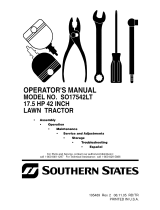
DANGER:Thiscuttingmachineiscapableof amputatinghandsandfeet andthrowing
objects.Failuretoobservethefollowingsafetyinstructionscouldresultin seriousinjury
or death.
WARNING: Inorderto prevent
accidentalstartingwhensettingup,
transporting,adjustingor makingrepairs,
alwaysdisconnectsparkplugwire and
placewirewhereitcannotcontactspark
plug.
WARNING: Donotcoastdowna
hillin neutral,youmaylosecontrolofthe
tractor.
WARNING: Towonlytheattach-
mentsthatare recommendedbyand
complywith specificationsofthe man-
ufacturerof yourtractor.Usecommon
sensewhentowing.Operateonlyat the
lowestpossiblespeedwhenon a slope.
Tooheavyof a load,while on aslope,is
dangerous. Tirescan losetractionwith
thegroundandcauseyouto losecontrol
of yourtractor.
WARNING:Engineexhaust,some
of itsconstituents,andcertainvehicle
componentscontainoremitchemicals
knownto theStateof Californiato cause
cancerandbirth defectsor otherrepro-
ductiveharm.
WARNING:Batteryposts,terminals
andrelatedaccessoriescontainleadand
leadcompounds,chemicalsknownto the
Stateof Californiato causecancerand
birthdefectsorother reproductiveharm.
Wash hands after handling.
I. GENERAL OPERATION
• Read, understand, and follow all
instructions on the machine and in the
manual before starting.
• Do not put hands or feet near rotating
parts or under the machine. Keep clear
of the discharge opening at all times.
• Only allow responsible adults, who are
familiar with the instructions, to operate
the machine.
• Clear the area of objects such as
rocks, toys, wire, etc., which could be
picked up and thrown by the blades.
• Be sure the area is clear of bystand-
ers before operating. Stop machine if
anyone enters the area.
• Never carry passengers.
• Do not mow in reverse unless abso-
lutely necessary. Always look down
and behind before and while backing.
3
• Never direct discharged material
toward anyone. Avoid discharging
material against a wall or obstruction.
Material may ricochet back toward the
operator. Stop the blades when cross-
ing gravel surfaces.
• Do not operate machine without the
entire grass catcher, discharge guard,
or other safety devices in place and
working
• Slowdown before turning.
• Never leave a running machine
unattended. Always turn off blades,
set parking brake, stop engine, and
remove keys before dismounting.
• Disengage blades when not mowing.
Shut off engine and wait for all parts to
come to a complete stop before clean-
ing the machine, removing the grass
catcher, or unclogging the discharge
guard.
• Operate machine only in daylight or
good artificial light.
• Do not operate the machine while
under the influence of alcohol or drugs.
• Watch for traffic when operating near
or crossing roadways.
• Use extra care when loading or unload-
ing the machine into a trailer or truck.
• Always wear eye protection when oper-
ating machine.
• Data indicates that operators, age 60
years and above, are involved in a
large percentage of riding mower-re-
lated injuries. These operators should
evaluate their ability to operate the
riding mower safely enough to protect
themselves and others from serious
injury
• Follow the manufacturer's recommen-
dation for wheel weights or counter-
weights.
• Keep machine free of grass, leaves or
other debris build-up which can touch
hot exhaust / engine parts and burn.
Do not allow the mower deck to plow
leaves or other debris which can cause
build-up to occur. Clean any oil or fuel
spillage before operating or storing the
machine. Allow machine to cool before
storage.





















